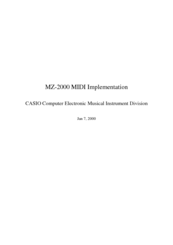User Manuals: Casio MZ-2000 Digital Workstation
Manuals and User Guides for Casio MZ-2000 Digital Workstation. We have 3 Casio MZ-2000 Digital Workstation manuals available for free PDF download: User Manual, Midi Implementation Manual, Service Manual
Casio MZ-2000 User Manual (219 pages)
Brand: Casio
|
Category: Synthesizer
|
Size: 16.52 MB
Table of Contents
Advertisement
Casio MZ-2000 Midi Implementation Manual (51 pages)
Casio MZ-2000: User Guide
Brand: Casio
|
Category: Electronic Keyboard
|
Size: 0.17 MB
Table of Contents
Casio MZ-2000 Service Manual (35 pages)
ELECTRONIC KEYBOARD
Brand: Casio
|
Category: Electronic Keyboard
|
Size: 5.56 MB
Table of Contents
Advertisement


